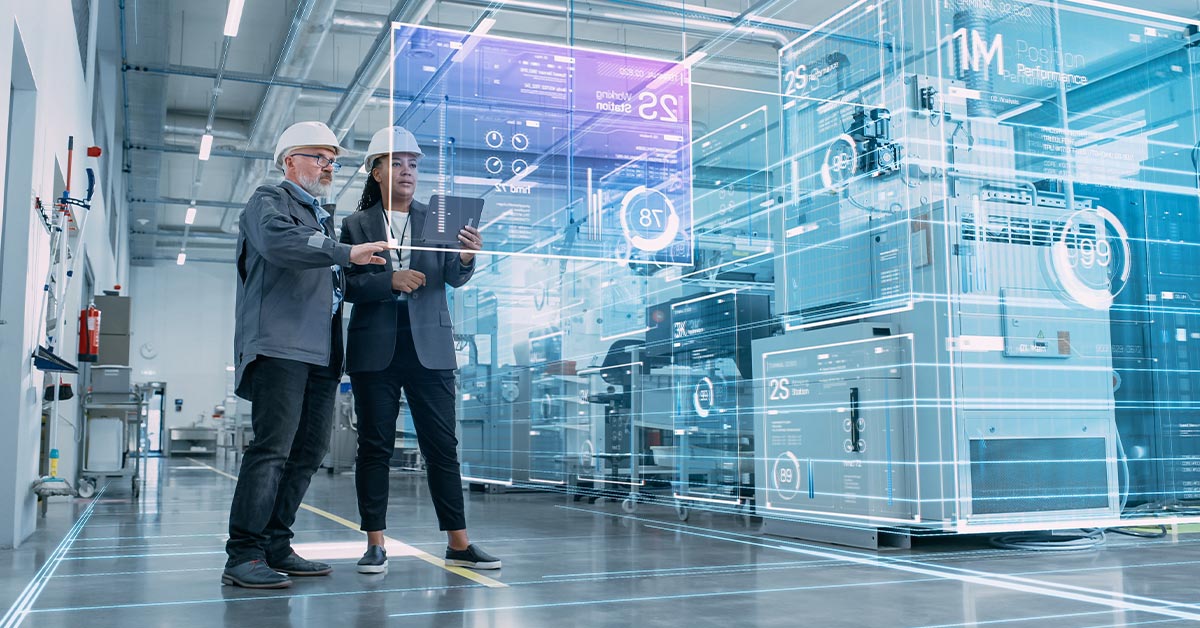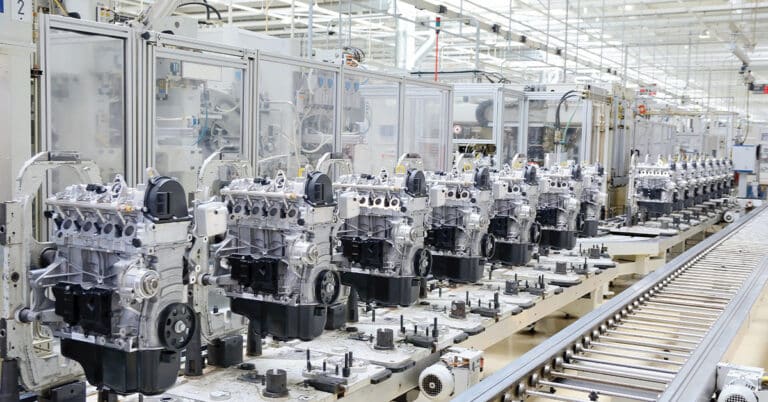Artificial intelligence, predictive maintenance and digital twins are just some of the new things happening in manufacturing right now. For many businesses, the biggest challenge is figuring out which technologies to adopt and how to profit from them. The few that are doing this well are considered “digitally mature.” Most, though, are still trying to make sense of this digital transformation in manufacturing.
In this blog, we’ll examine the change that’s underway and the key technologies driving it. We’ll discuss emerging trends in manufacturing and review what’s involved in, and the benefits to be expected from, a factory digital transformation. By the end, you’ll be able to explain the challenges and benefits of this makeover.
What is digital transformation in manufacturing?
Since the first Industrial Revolution, manufacturers have used machinery to turn raw materials into products that people and other businesses need. Over time, this machinery was mechanized and then automated in the pursuit of lower costs, better quality and higher profits.
Despite this tremendous effort and expenditure, manufacturers continue to battle waste and inefficiency. Variation leads to scrap, and machine breakdowns result in delivery delays and higher-than-expected costs. What’s long been sought, and is only now becoming available, is data on which to make decisions about manufacturing.
Today machines can be outfitted with a host of sensors to report on every aspect of their health. Parts and processes can be measured in real-time, and software can model how physical systems will perform in any given situation. We are moving towards an era where manufacturers have data on every aspect of their processes.
This digitalization of manufacturing data is a vital step, but it alone isn’t transformational. That comes about by using the data and linking systems to gain new insights into manufacturing, thereby finding new opportunities for improvement that lead to changes in efficiency and productivity.
Key technologies driving the digitalization of manufacturing
Three major changes are fueling new trends in manufacturing: Sensors are getting smaller, cheaper and more capable; communications technologies have become dramatically faster, with greatly increased bandwidth and both wired and wireless options; and the ability of software to find patterns and trends and draw conclusions from this data is growing exponentially.
These advances are revolutionary and often described as “Industry 4.0 technologies,” referring to this digitalization as a fourth Industrial Revolution. To understand what these changes can do for manufacturers, it’s important to understand the main vectors of change. These are considered to be:
- Machine learning and artificial intelligence: The computers used in modern manufacturing need programming so they can control motion devices like robots or make decisions about what’s in images. Machine learning (ML), which is a subset of artificial intelligence (AI), is an approach to programming based on training rather than defining rigid rules. Through supervised or unsupervised training, an ML program creates a weighted network that lets it determine an outcome based on weighted probabilities of multiple inputs. Applications of artificial intelligence in manufacturing include quality control, inventory management and process optimization.
- Condition monitoring sensors: Vibration, temperature and pressure are just a few of the types of sensors used in manufacturing to monitor machine operation. When equipped with signal processing and communications capabilities, these can report exceptions or deviations from normal conditions to computerized maintenance management systems (CMMS) for decisions on what to attend to, how and when.
- Predictive maintenance: This maintenance strategy combines sensor data with machine history in the CMMS to generate recommendations for maintenance work. Predictive maintenance tools target inspections, servicing and repair more effectively than preventive maintenance, reducing disruption and improving availability.
- Digital twins: These are software representations of real-world structures or systems that are linked to the real world so they are continuously updated and always current. This technology can serve both products and manufacturing cells and lines. Digital twins in manufacturing enable training, virtual commissioning, remote maintenance support and risk-free experimentation for optimization.
- Augmented reality and virtual reality: For augmented reality (AR) a user wears glasses equipped with small screens linked to a computer. Software displays relevant information on the screens. AR glasses are used for remote support and training. Virtual reality (VR) requires a full headset that puts the user into a virtual world. This is used in factory simulations, letting the wearer observe workflows and automated handling systems that have not yet been built. AR and VR in manufacturing can increase maintenance effectiveness, reduce response times and help optimize future manufacturing operations.
- Robotics: While industrial robots have been automating dirty, difficult and dangerous tasks for decades, two recent innovations have greatly increased their value. These are collaborative robots (cobots) and AI. Cobots incorporate safety features that let them work alongside and even with human workers. AI can be used to:
- Help a robot work in an unstructured workplace
- Let robots perform automated inspection
- Develop highly optimized motion paths
- 3D printing: The use of 3D printing in manufacturing is growing rapidly, as metal additive technologies mature. Today, while plastic pieces are still printed for prototyping tooling and workholding, metal replacement machinery components and actual production parts are possible. When combined with generative design, this enables the manufacture of shapes that can’t be produced any other way, such as weight-saving brackets and supports.
Trends emerging from the manufacturing digital transformation
The digital transformation in the manufacturing industry is giving managers new tools for tackling goals like raising OEE, reducing inventories and costs, and providing faster delivery performance. Four manufacturing industry trends hold great promise for increased efficiency and productivity.
- Predictive analytics: Manufacturers eager to eliminate unplanned machine stoppages are increasingly adopting predictive analytics to optimize maintenance. Achieved through a combination of advanced sensors and CMMS tools, this also drives down maintenance costs and inventories.
- Lean manufacturing: Lean manufacturing is strongly focused on waste elimination, and digital technology will have a big impact on these efforts. Advanced robotics will increase flexibility and support shorter production runs, while smart sensors will help reduce process variability.
- Emphasis on safety: Responsible manufacturers always maintain a focus on safety, but new digital technology gives them additional tools. A prime example is the cobot, where advanced sensors let people work productively in close proximity to the machine.
- Smart factories and IIoT: For the manufacturing industry, digital transformation is about combining multiple advances to create smart factories built around Industrial Internet of Things (IIoT) technology. Maximizing ROI requires a smart factory strategy be developed first, making this a key digital transformation trend.
Challenges & benefits
Making a digital transformation is not simple or straightforward. It should be viewed as an enterprise-wide effort that requires a firm commitment from senior leadership. Cost and resources are challenges, but the way to tackle these is by educating leaders and explaining the benefits.
Several organizations have researched and reported on the digital transformation process. Some of the available case studies are from other industries, but the number of digital transformation examples in manufacturing is growing. Some particularly relevant data points include:
- Only one in four manufacturers has a digital transformation strategy, and less than half have begun making a transformation (so developing one will put your organization in the vanguard).
- A large proportion of manufacturers expect to need help from external experts to make their transition.
- The main benefits anticipated are lower costs, improved data visibility (which helps identify further improvement opportunities) and higher reliability.
When comparing organizations where the transformation is well underway (those considered “digitally mature”) with those yet to embark on the process, the “mature” group experienced revenue growth up to 45% higher, and margin growth up to 43% higher, than those less mature.
Implementing and optimizing your digital transformation strategy
Having secured top management support, the next step is to develop the strategy and put it to work. Specific actions will vary depending on the type of manufacturing and business, but the strategy will include elements of the following:
- Determine current status regarding adoption of digital technologies.
- Establish goals for what you want to achieve.
- Set some priorities and create a plan for achieving them.
- Consider focusing resources on areas that will yield the biggest impact. This will not only impact the bottom line immediately but will also help win support from any naysayers.
- Enlist support from domain experts such as machine maintenance specialists.
- Follow through with the implementation plan, conducting regular reviews to identify any areas that fall behind.
It’s important to recognize that achieving a digital transformation will involve and affect all aspects of the business, from sales to shipping. This emphasizes the need for winning hearts and minds in the early stages, since the transformation is a big undertaking that will take a long time to carry out.
Take advantage of maintenance expertise from ATS
The digital transformation underway in manufacturing has been described as the fourth Industrial Revolution, or Industry 4.0, and that’s probably no exaggeration. While the technologies involved are increasingly well-proven, putting it all together is a big step that requires a strategy involving all parts of the organization.
Equipment maintenance is a key part of this transformation, and a major beneficiary. With data on processes and machinery condition, maintenance needs are predictable and unplanned downtime can be prevented, resulting in higher margins and increased growth.
As a leader in technology-driven maintenance services, ATS is ready to help manufacturers digitally evolve their maintenance strategy. Contact us to get started.


